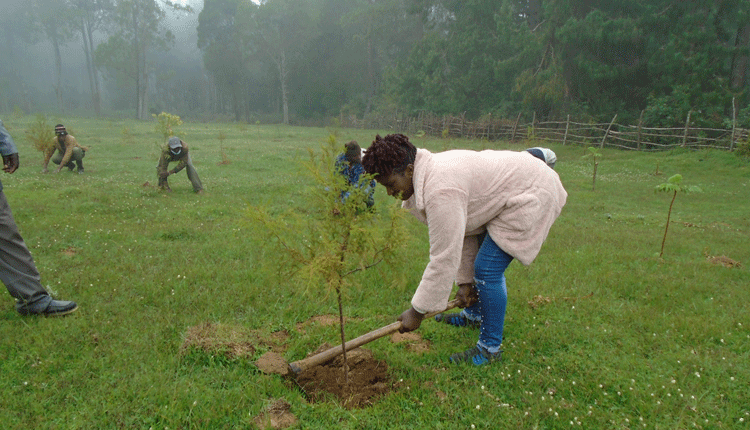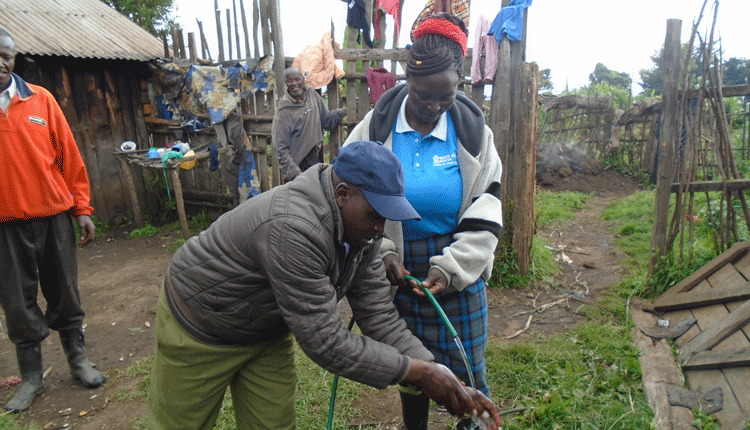Community group fights to rebuild destroyed ecosystem
By Milliam Murigi, October 5, 2021A few years ago, Rahab Wangeci Karanja and her children used to walk for kilometres to fetch water.
They were also forced to go farther away to collect non-timber forest products because they could hardly get them near their village, despite the fact that their home is adjacent to Abadares Forest, one of the major water towers in Kenya.
Rahab’s family, which hails from Kiburu Village, South Kinangop, Nyandarua county, was not the only one affected.
Most families used to walk for at least five kilometres on a daily basis to fetch water and other necessities because most nearby rivers had dried up due to forest degradation.
The catchment is a source for Turasha, Kariahu, and many streams draining to Lake Naivasha.
Science says healthy forests make healthy rivers and lakes, but loggers and villagers had invaded the forest and cleared the bigger part of it consequently leaving most rivers dry or highly polluted.
“Walking for such long distances made our children miss school often and women were always late to attend to other duties.
Despite the long journey, it wasn’t assured one will get clean drinking water.
Sometimes we were forced to drink unsafe water and you know the consequences,” she says.
However, things have changed and today Wangeci and other families have water connections to their homesteads.
They get water round the clock. According to her, the transformation is because the communities around the forest have started restoring the forest to its initial status.
“We realised the more we destroyed the forest, the worse the situation became. As a community, we decided to join hands, form an association and start restoring the forest for our own benefits.
That is how Abadare-Kiburu Community Forest Association (CFA) was borne,” she says.
Though the association was born in 2007, it started its tree-planting initiative in 2013.
Today they have restored about 250 acres of the forest with the help of different organisations.
Lately, their conservation effort was enhanced following the initiation of a new forest landscape restoration project.
Dubbed Lake Naivasha Basin Afforestation Project funded by Coop Switzerland and World Wildlife Fund (WWF) Switzerland through WWF Kenya, the initiative seeks to restore about 2,875 acres of forest areas on farmlands, and 288 acres of biodiversity area.

Photo/PD/MILLIAM MURIGI
Before they commenced the restoration process, loggers had fallen trees leaving a tree cover of about 30 to 40 per cent and putting both people and wildlife in danger.
Today the levels have gone down to two per cent and the association with the help of Kenya Forest Services (KFS) aims to abolish it completely.
“Since we started our restoration project, we have witnessed a lot of changes in our ecosystem.
Water levels in our rivers have gone up and the quality has improved greatly.
Because of these women are no longer going to the rivers to fetch water since they are benefitting from improved water supplies,” she says.
Earning a living
Apart from that, Wangeci reveals that community members have also been given an opportunity to farm in the forest as they take care of the trees and at the same time to keep away loggers.
To her, this has economically empowered women and youths since most of them are now able to earn a living from forest farming.
According to Patrick Mwaniki, one of the youths who have been farming in the forest since last year, successful restoration has generated a wide range of benefits such as enhanced food security, improved air and water quality, climate change resilience, job creation, and many more.
“Before most of our rivers were polluted, but this is not the case now. This is because healthy forests filter sediments and pollutants from rainwater runoff thus protecting the quality of water that gets to our rivers and lakes,” says Mwaniki.
He adds that forest farming has also brought crime levels down since most youths who used to engage in those vices are now busy at the farms.
His group, Karandi Youth Group has secured about 50 acres inside the forest where they farm potatoes.
According to James Kariuki Karanja, the chairman of the association, the initiative is not only looking into tree-planting but also protecting land from uses that led to deforestation and degradation in the first place.
They are also improving productivity of rural landscapes by integrating trees on farms.
They are doing so by increasing the number of trees across the landscape and preventing land degradation through improved agricultural practices.
“We work in partnership with KFS to ensure that we increase the forest cover.
Though at first communities around this forest were resistant to join our association, we now have more than 30 groups that have come on board to ensure that we successfully restore this forest to its original status.
And what has led to this change? Gabriel Macharia, a farmer whose farm is one kilometre away from the forest, says poor harvests and lack of irrigation water is motivating more farmers to join the association.
He says forest destruction left farmers in most parts of Nyandurua county relying heavily on rain-fed agriculture yet rainfall patterns had also changed.
“I joined this association because I wanted to learn why our rivers were drying and what we can do as a community to restore them.
Getting into the forest during one of the tours, I realised the forest had been destroyed to an extent that it could no longer provide its ecosystem services,” says Macharia.
Indigenous trees
Forests provide ecosystem services, such as timber, food, fuel, fodder, non-wood products, and shelter which are essential for human well-being.
At the same time, they contribute to soil and water conservation, carbon storage, and clean air.
“We have been planting indigenous trees in most parts of this forest and that is why it has taken us this long to realise the restoration benefits. Indigenous trees take longer to grow, unlike the exotic ones.
However, under WWF leadership we have also included exotic trees,” said Kariuki.
Besides planting trees, the CFA also earns income from indigenous trees seedlings nurseries they run.
They sell seedlings to individuals and groups. So far they have earned Sh1.2 million from the project started a year ago.
They also engage in other activities such as beekeeping, eco-tourism, and fish rearing.
According to WWF-Kenya Naivasha Landscape coordinator Caroline Njiru, part of this initiative also aims at supplementing government efforts in achieving its target to restore 12.6 million acres of degraded landscapes by 2022 under the Bonn Challenge.
The Bonn Challenge, is a global effort for land restoration targeting to bring 370 million acres of the world’s deforested and degraded land into restoration by 2020, and 865 million hectares by 2030.
Caroline says they decided to work with communities for the implementation of this initiative because this is the most sustainable solution to land degradation and an effective way for restoration.
To ensure that communities fully benefit from this initiative, the organisation buys the seedlings from community-managed tree nurseries.
“We decided to empower communities to produce and plant the trees because this is the best sustainable option for achieving the target of increased forest cover, restoration of agricultural lands, and adaptation to climate change while also reducing poverty among rural communities. So far the outcome is impressive,” says Njiru, calling for communities to be put at the centre of conservation efforts.
